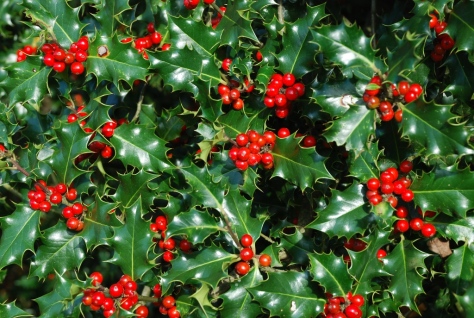
Since today’s Ancient Calendar marks the season of the Holly King, (Read Here), I thought, what could be a better opportunity than right here and now to delve deeper into the folk medicine and lore of something we are all somewhat familiar with.
Holly actually has quite a few nicknames. For the Celtic Tree Month, we know it by Tinne, but it is also called, Christ’s Thorn, Bat’s Wings, Holm Chaste, Hulver Bush, Aquifolius and Hulm. It’s proper name would be quite the tongue twister, Ilex aquifolium or I. Opaca.
Here in the mountains, we know it as Holly and it’s something that stretches as far as landscaping to the table and wreaths inside our homes. And while today, most of us are oblivious to it’s true history or purpose, not so long ago, those dead and gone from these mountains, knew it all quite well.
While present day Pagans might plant Holly by the front door for protection, it wasn’t much different in times of old. Not only did people believe that Holy warded off evil spirits but they also believed it kept them safe from lightning, dark sorcery and poison.
People used to make something called, Holly Water. Was this the origins of “Holy Water”? They would make Holly Water by infusing water with Holly. This was used to protect babies, especially when they were first born, by sprinkling a few drops of the water upon their heads, much like baptism.
Holly was deemed so powerful, when thrown at wild animals, people believed it made them lie down and grow silent.
It was carried by people for luck – especially by men– and hung around the home at Yule for an extra dose of something special.
According to, Cunningham’s Encyclopedia of Herbs, there was even a special ritual surrounding Holly. It had to be done on a Friday after Midnight, but if someone gathered nine Holly Leaves (from a smooth plant) and wrapped them in a white cloth created nine knots, then they could sleep with it under their pillow– making their dreams come true.
Medically, the leaves, berries and bark is used. The berries are actually harmful to people. Animals, however, love the Holly Bush. Deer eat them during winter. Birds feast on the berries and for those who keep rabbits, a stick placed in a rabbit hut, will give them something to gnaw in order to restore their appetites. A tonic, if you will.
In olden times, Holly was used to treat smallpox, pleurisy, fevers, rheumatism, and catarrh. It’s leaves were used in tea and because of it’s tannins, it is known as a good blood purifier, diuretic and was also, highly revered as a diaphoetic (which made it good for fevers and such).
